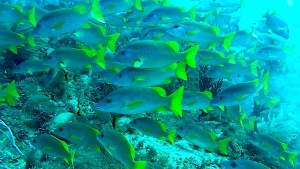Liutanidi - Lutjanidae
Liutanidi Lutjanidae Snappers Dentici intotheblue.it
Azzannatore gobbo - Lutjanus gibbus
Dentice Azzannatore Maculato - Lutjanus monostigma
Dentice Lutjanus Apodus
Snapper maestro di scuola - Lutjanus apodus
Snappers are a family of perciform fish, Lutjanidae, mainly marine, but with some members inhabiting estuaries, feeding in fresh water. The family includes about 113 species. Some are important food fish. One of the best known is the red snapper.

Snappers inhabit tropical and subtropical regions of all oceans. Some snappers grow up to about 1 m (3.3 ft) in length however one specific Snapper, the Cubera Snapper, grows up to 5 ft in length. Most are active carnivores, feeding on crustaceans or other fish, though a few are plankton-feeders. They can be kept in aquaria, but mostly grow too fast to be popular aquarium fish. Most species live at depths reaching 100 m (330 ft) near coral reefs, but some species are found up to 500 m (1,600 ft) deep.
As other fish, snappers harbour parasites. A detailed study conducted in New Caledonia has shown that coral reef-associated snappers harbour about 9 species of parasites per fish species.

Distribution and habitat This family is present in all tropical and subtropical seas and oceans.
To date, four species have been reported in the Mediterranean Sea, none of which are considered naturalized. Lutjanus argentimaculatus, of Lessepsian origin, known to date for two catches in Lebanese waters; Lutjanus jocu, coming from the western Atlantic and recently reported in the Ligurian Sea; Lutjanus fulviflamma, also Lessepsian, recently captured in Malta; Lutjanus sebae, reported in Greece as an introduction from the aquarium.
They are all marine and usually strictly coastal, abundant on coral reefs. Some species populate brackish waters and can be pushed for short periods in fresh water.

Description The appearance of these fish is reminiscent of the Sparidae or Haemulidae. The dorsal fin is unique with the front part composed of spiny rays, there may be a notch in the center of this fin. Three spiny rays are also present on the anal fin. The mouth is large, with robust jaws, armed with large and evident canine teeth. The related Caesionidae are similar but more tapered, with a small mouth and deeply forked caudal fin.
The coloring varies from slightly showy brownish to the most varied and lively colors with extremely variable designs between species and species and between young and adults.
They are large fish, many species exceed one meter in length and some even one and a half meters.
https://en.wikipedia.org/wiki/Lutjanidae https://it.wikipedia.org/wiki/Lutjanidae
https://en.wikipedia.org/wiki/Lutjanidae
https://it.wikipedia.org/wiki/Lutjanidae




